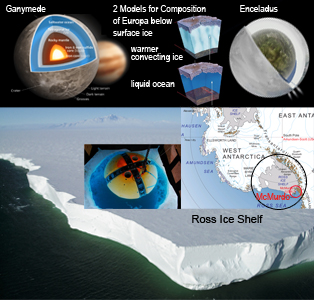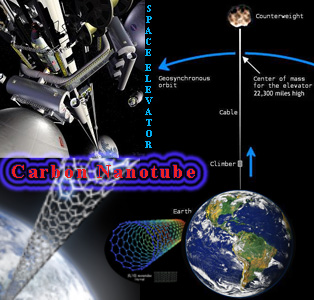Antarctica as Proving Ground for Space Exploration Technologies
Stone Aerospace advance team for the Autonomous Rover/airborne-radar Transects of the Environment beneath the McMurdo Ice Shelf (ARTEMIS) is schedule to reach Antarctica August 22 to set up a test lab. The main team will arrive with ARTEMIS at the end of September, just ahead of the southern hemisphere Spring season. It is designed to evaluate technologies and techniques for independent exploration of vast underground water systems. ARTEMIS will be consolidated into a project called Sub-glacial Polar Ice Navigation, Descent, and Lake Exploration (SPINDLE), along with other elements including a cryobot transport system to tunnel through thick surface ice and a number of small, disposable “marsupial robots”, designed to collect samples from hazardous areas and bring them back to the main AUV. Bill Stone, of Stone Aerospace, indicates that SPINDLE development and field-testing in Antarctic subglacial lakes is done in preparation for exploration at locations of highest interest in the search for life across the Solar System, such as Europa, Enceladus and Ganymede. The International Council for Science division known as the Scientific Committee on Antarctic Research (SCAR) just held the 3rd workshop of the Astronomy and Astrophysics from Antarctica research program in Volcano National Park, Hawai’i, USA. The extreme environments, physical isolation and regime for international science cooperation characteristic of Antarctica make it a very interesting analog and inspiration for future large-scale and long-term space science, exploration and development endeavors. (Image Credit: Kevin Hand (JPL/Caltech), Jack Cook (Woods Hole Oceanographic Institution), Howard Perlman (USGS) via NASA; NASA/JPL; NASA’s Planetary Photojournal, PIA01669) |
MONDAY
|

![]() = All times
= All times
for terrestrial events in local time unless noted.
![]() = All times for international terrestrial events in local time unless noted.
= All times for international terrestrial events in local time unless noted.
![]() = All times for space events, and…
= All times for space events, and…
![]() = All times for international space / astro events in Hawaii Standard Time unless noted. Add 10 hours to obtain UT (‘Universal Time;’ Greenwich, England).
= All times for international space / astro events in Hawaii Standard Time unless noted. Add 10 hours to obtain UT (‘Universal Time;’ Greenwich, England).
Weekly Planet Watch – Evening Planets: Mercury (W), Saturn (SW); Morning Planets: Mars (ENE), Uranus (S), Neptune (S).
ISEC 2015 and IAA Space Elevator Study Group Convene in Seattle
|
Continued from…
|
TUESDAY
![]() Aug 18 — Cassini, Saturn Orbit: Helene flyby scheduled at 113,000-km altitude.
Aug 18 — Cassini, Saturn Orbit: Helene flyby scheduled at 113,000-km altitude.
![]() Aug 18 — The Space Show, Online / Tiburon CA: Dr. David Livingston talks with Dennis Wingo; Space Show running an Indiegogo crowdfunding campaign to modernize current technologies & database from 15 years of programming.
Aug 18 — The Space Show, Online / Tiburon CA: Dr. David Livingston talks with Dennis Wingo; Space Show running an Indiegogo crowdfunding campaign to modernize current technologies & database from 15 years of programming.
![]() Aug 18 — California Institute of Technology, Pasadena CA: Lecture: The Implications of U.S. Space Policy Choices; presented by Dr. Scott Pace, Director of Space Policy Institute.
Aug 18 — California Institute of Technology, Pasadena CA: Lecture: The Implications of U.S. Space Policy Choices; presented by Dr. Scott Pace, Director of Space Policy Institute.
![]() Aug 18 — Lunar and Planetary Institute, Houston TX: LPI Seminar Series: Polygonal Patterns and Desert Eyes: Discovery and Study of Pervasively Developed Bedrock Structures in the Western Desert of Egypt Using Freely Available High Resolution Satellite Imagery; presented by Barbara Tewksbury, Hamilton College.
Aug 18 — Lunar and Planetary Institute, Houston TX: LPI Seminar Series: Polygonal Patterns and Desert Eyes: Discovery and Study of Pervasively Developed Bedrock Structures in the Western Desert of Egypt Using Freely Available High Resolution Satellite Imagery; presented by Barbara Tewksbury, Hamilton College.
![]() Aug 18 — Mercury: 1.1° S of asteroid 3 Juno, 16:00.
Aug 18 — Mercury: 1.1° S of asteroid 3 Juno, 16:00.
WEDNESDAY
![]() Aug 19 — University of Arizona, Tucson AZ: Space Drafts Public Talk Series: Pluto: Up Close and Personal; presented by Dr Veronica Bray.
Aug 19 — University of Arizona, Tucson AZ: Space Drafts Public Talk Series: Pluto: Up Close and Personal; presented by Dr Veronica Bray.
![]() Aug 19-21 — Chandra X-ray Center, Cambridge MA: Chandra Workshop: The Universe in High-resolution X-ray Spectra – Current Results and Future Opportunities.
Aug 19-21 — Chandra X-ray Center, Cambridge MA: Chandra Workshop: The Universe in High-resolution X-ray Spectra – Current Results and Future Opportunities.
![]() Aug 19 — Moon: 4.1° NNE of Spica, 11:00.
Aug 19 — Moon: 4.1° NNE of Spica, 11:00.
![]() Aug 19 — Apollo Asteroid 2015 OF26: Near-Earth flyby (0.099 AU).
Aug 19 — Apollo Asteroid 2015 OF26: Near-Earth flyby (0.099 AU).
THURSDAY
![]() Aug 20 — ISS, Kounotori HTV-5 Rendezvous & Berthing, LEO: Japan 5th H-2 transfer vehicle (Kounotori 5) to rendezvous, be captured & berthed to ISS; activities begin 09:30 UT, live coverage available.
Aug 20 — ISS, Kounotori HTV-5 Rendezvous & Berthing, LEO: Japan 5th H-2 transfer vehicle (Kounotori 5) to rendezvous, be captured & berthed to ISS; activities begin 09:30 UT, live coverage available.
![]() Aug 20 — Cassini OTM-419, Saturn Orbit: Spacecraft conducts Orbital Trim Maneuver #419 today.
Aug 20 — Cassini OTM-419, Saturn Orbit: Spacecraft conducts Orbital Trim Maneuver #419 today.
![]() Aug 20 — Voyager 2, Heliosheath: NASA spacecraft enters 39th year in space today, launched Aug 20, 1977 – seventeen days before Voyager 1; expected to send data to Earth until ~2025 when power may run out.
Aug 20 — Voyager 2, Heliosheath: NASA spacecraft enters 39th year in space today, launched Aug 20, 1977 – seventeen days before Voyager 1; expected to send data to Earth until ~2025 when power may run out.
![]() Aug 20 — Arianespace, Launch Ariane 5 / Eutelsat 8 West B & Intelsat 34, Kourou, French Guiana: Arianespace Ariane 5 ECA rocket, designated VA225, to launch Eutelsat 8 West B & Intelsat 34 satellites.
Aug 20 — Arianespace, Launch Ariane 5 / Eutelsat 8 West B & Intelsat 34, Kourou, French Guiana: Arianespace Ariane 5 ECA rocket, designated VA225, to launch Eutelsat 8 West B & Intelsat 34 satellites.
![]() Aug 20 — International Academy of Astronautics, Seattle WA: Study Group: Road to Space Elevator Era; with Akira Tsuchida, David Raitt, Peter Swan, Sakurako Takahashi, and others.
Aug 20 — International Academy of Astronautics, Seattle WA: Study Group: Road to Space Elevator Era; with Akira Tsuchida, David Raitt, Peter Swan, Sakurako Takahashi, and others.
![]() Aug 20-21 — University of Arizona, Lunar and Planetary Laboratory, Tucson AZ: Lunar and Planetary Laboratory Conference (LPLC).
Aug 20-21 — University of Arizona, Lunar and Planetary Laboratory, Tucson AZ: Lunar and Planetary Laboratory Conference (LPLC).
![]() Aug 20-22 — National Optical Astronomy Observatory (NOAO), Large Synoptic Survey Telescope Science Group, Bremerton WA: LSST Observing Strategy Workshop.
Aug 20-22 — National Optical Astronomy Observatory (NOAO), Large Synoptic Survey Telescope Science Group, Bremerton WA: LSST Observing Strategy Workshop.
![]() Aug 20 — Mars: 0.22° S of Beehive Cluster, 08:00.
Aug 20 — Mars: 0.22° S of Beehive Cluster, 08:00.
FRIDAY
![]() Aug 21-23 — International Space Elevator Consortium, Seattle WA: 2015 Space Elevator Conference; at Museum of Flight.
Aug 21-23 — International Space Elevator Consortium, Seattle WA: 2015 Space Elevator Conference; at Museum of Flight.
![]() Aug 21-30 — Nordic Network of Astrobiology, Moletai, Lithuania: Summer School: Formation and Evolution of Planetary Systems and Habitable Planets.
Aug 21-30 — Nordic Network of Astrobiology, Moletai, Lithuania: Summer School: Formation and Evolution of Planetary Systems and Habitable Planets.
SATURDAY
![]() Aug 22 — Stone Aerospace, McMurdo Station, Antarctica: Prep team to set up a lab on ice before main science team arrives at end of Sep to test ARTEMIS (Autonomous Rover/airborne-radar Transects of the Environment beneath the McMurdo Ice Shelf).
Aug 22 — Stone Aerospace, McMurdo Station, Antarctica: Prep team to set up a lab on ice before main science team arrives at end of Sep to test ARTEMIS (Autonomous Rover/airborne-radar Transects of the Environment beneath the McMurdo Ice Shelf).
![]() Aug 22 — Moon: 2.6° NNE of Saturn, 09:00; at first quarter, 09:31.
Aug 22 — Moon: 2.6° NNE of Saturn, 09:00; at first quarter, 09:31.
![]() Aug 22 — Apollo Asteroid 206378 (2003 RB): Near-Earth flyby (0.053 AU).
Aug 22 — Apollo Asteroid 206378 (2003 RB): Near-Earth flyby (0.053 AU).
SUNDAY
![]() Aug 23 — ISS, Kounotori HTV-5 Capture & Berthing, LEO: Uncrewed JAXA 5th H-2 transfer vehicle (Kounotori 5) to rendezvous with ISS.
Aug 23 — ISS, Kounotori HTV-5 Capture & Berthing, LEO: Uncrewed JAXA 5th H-2 transfer vehicle (Kounotori 5) to rendezvous with ISS.
![]() Aug 23 — Orthodox Academy of Creta (OAC), European Organization for Nuclear Research, Kolymbari, Greece: 4th International Conference on New Frontiers in Physics.
Aug 23 — Orthodox Academy of Creta (OAC), European Organization for Nuclear Research, Kolymbari, Greece: 4th International Conference on New Frontiers in Physics.
![]() Aug 23 — Moon: 9.4° N of Antares, 05:00.
Aug 23 — Moon: 9.4° N of Antares, 05:00.

